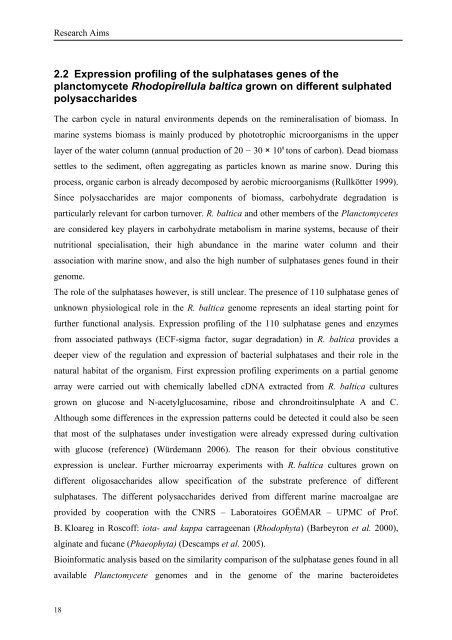a Whole Genome Array Approach - Jacobs University
a Whole Genome Array Approach - Jacobs University
a Whole Genome Array Approach - Jacobs University
You also want an ePaper? Increase the reach of your titles
YUMPU automatically turns print PDFs into web optimized ePapers that Google loves.
Research Aims<br />
2.2 Expression profiling of the sulphatases genes of the<br />
planctomycete Rhodopirellula baltica grown on different sulphated<br />
polysaccharides<br />
The carbon cycle in natural environments depends on the remineralisation of biomass. In<br />
marine systems biomass is mainly produced by phototrophic microorganisms in the upper<br />
layer of the water column (annual production of 20 − 30 × 10 9 tons of carbon). Dead biomass<br />
settles to the sediment, often aggregating as particles known as marine snow. During this<br />
process, organic carbon is already decomposed by aerobic microorganisms (Rullkötter 1999).<br />
Since polysaccharides are major components of biomass, carbohydrate degradation is<br />
particularly relevant for carbon turnover. R. baltica and other members of the Planctomycetes<br />
are considered key players in carbohydrate metabolism in marine systems, because of their<br />
nutritional specialisation, their high abundance in the marine water column and their<br />
association with marine snow, and also the high number of sulphatases genes found in their<br />
genome.<br />
The role of the sulphatases however, is still unclear. The presence of 110 sulphatase genes of<br />
unknown physiological role in the R. baltica genome represents an ideal starting point for<br />
further functional analysis. Expression profiling of the 110 sulphatase genes and enzymes<br />
from associated pathways (ECF-sigma factor, sugar degradation) in R. baltica provides a<br />
deeper view of the regulation and expression of bacterial sulphatases and their role in the<br />
natural habitat of the organism. First expression profiling experiments on a partial genome<br />
array were carried out with chemically labelled cDNA extracted from R. baltica cultures<br />
grown on glucose and N-acetylglucosamine, ribose and chrondroitinsulphate A and C.<br />
Although some differences in the expression patterns could be detected it could also be seen<br />
that most of the sulphatases under investigation were already expressed during cultivation<br />
with glucose (reference) (Würdemann 2006). The reason for their obvious constitutive<br />
expression is unclear. Further microarray experiments with R. baltica cultures grown on<br />
different oligosaccharides allow specification of the substrate preference of different<br />
sulphatases. The different polysaccharides derived from different marine macroalgae are<br />
provided by cooperation with the CNRS – Laboratoires GOËMAR – UPMC of Prof.<br />
B. Kloareg in Roscoff: iota- and kappa carrageenan (Rhodophyta) (Barbeyron et al. 2000),<br />
alginate and fucane (Phaeophyta) (Descamps et al. 2005).<br />
Bioinformatic analysis based on the similarity comparison of the sulphatase genes found in all<br />
available Planctomycete genomes and in the genome of the marine bacteroidetes<br />
18

















